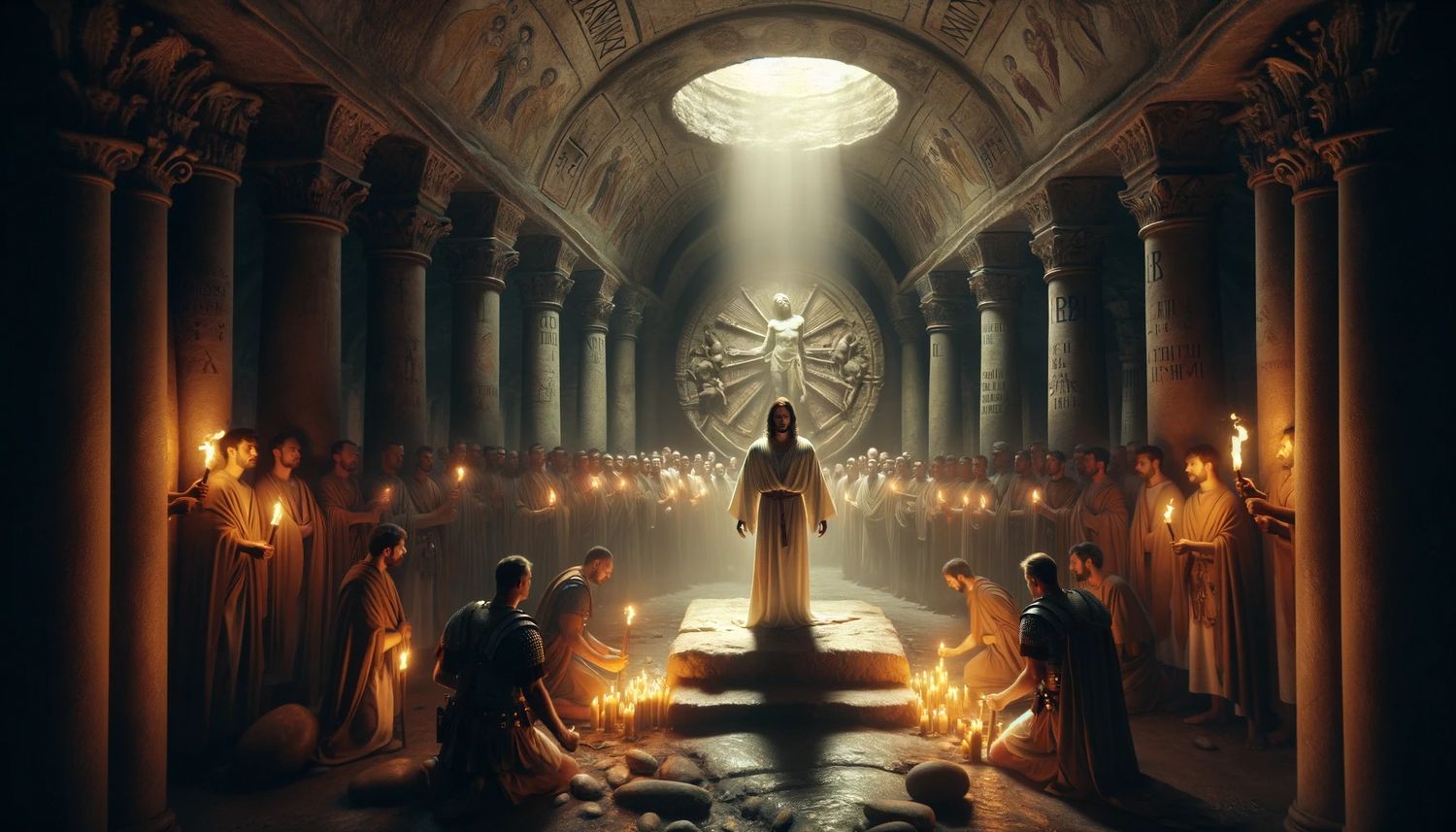Home>Theology and Spirituality>What To Expect At Baptism


Theology and Spirituality
What To Expect At Baptism
Published: February 29, 2024
Peter Smith, Editorial Director at Christian.net, combines deep insights into faith, politics, and culture to lead content creation that resonates widely. Awarded for his contributions to religious discourse, he previously headed a major organization for religious communicators, enhancing dialogue on faith's societal impacts.
Discover the significance of baptism and its role in theology and spirituality. Learn what to expect and how it can deepen your faith journey.
(Many of the links in this article redirect to a specific reviewed product. Your purchase of these products through affiliate links helps to generate commission for Christian.net, at no extra cost. Learn more)
Table of Contents
The Significance of Baptism
Baptism holds a significant place in the Christian faith, symbolizing the cleansing of sin and the initiation into the community of believers. It is a sacred rite that marks the beginning of a person's journey of faith and their commitment to following the teachings of Jesus Christ. The act of baptism is rooted in the teachings of Jesus, who was himself baptized by John the Baptist in the Jordan River. This event serves as a model for Christians, emphasizing the importance of baptism as a public declaration of one's faith and a symbol of spiritual rebirth.
-
Cleansing of Sin: Baptism is seen as a symbolic cleansing of sin, representing the washing away of past wrongdoings and the start of a new life in Christ. It is a visible sign of God's forgiveness and grace, marking the individual's acceptance into the family of believers.
-
Initiation into the Christian Community: Through baptism, individuals are welcomed into the Christian community, becoming part of a larger spiritual family. This act of initiation signifies a commitment to living out the values and beliefs of the Christian faith, as well as participating in the life of the church.
-
Identification with Christ's Death and Resurrection: In the Christian tradition, baptism is viewed as a participation in the death and resurrection of Jesus Christ. As the individual is immersed in water or has water poured over them, it symbolizes a dying to their old way of life and rising to a new life in Christ.
-
Sealing with the Holy Spirit: Baptism is also associated with the receiving of the Holy Spirit, who is believed to dwell within the baptized individual, guiding and empowering them in their spiritual journey.
-
Obligation to Live a Christian Life: Baptism carries with it the responsibility to live according to the teachings of Jesus and to actively participate in the life of the church. It serves as a public declaration of one's commitment to following the Christian path and upholding the values of love, compassion, and service to others.
In summary, the significance of baptism lies in its representation of spiritual rebirth, initiation into the Christian community, and the individual's commitment to living a life in accordance with the teachings of Jesus Christ. This sacred rite holds deep meaning for believers and serves as a foundational step in their journey of faith.
Read more: 20 Prayers For Expectant Mothers
The Role of Parents and Godparents
-
Parents' Responsibility: The parents of a child being baptized play a crucial role in the religious upbringing of their child. They are responsible for nurturing the child's faith and guiding them in their spiritual journey. By presenting their child for baptism, parents affirm their commitment to raising their child within the Christian faith, providing them with a foundation of love, support, and moral guidance.
-
Selection of Godparents: Godparents are chosen by the parents to serve as spiritual mentors and guides for the child. Their role is to support the parents in nurturing the child's faith and to serve as examples of Christian living. Godparents are typically individuals who are themselves committed to the Christian faith and are willing to take an active role in the child's religious education and moral development.
-
Spiritual Guidance: Godparents are expected to pray for the child and to provide spiritual support as they grow in their understanding of the Christian faith. They may also play a role in the child's religious education, offering guidance and wisdom as the child navigates their own beliefs and values.
-
Lifelong Commitment: The role of godparents extends beyond the baptismal ceremony, as they are called to maintain a lifelong relationship with the child, offering love, encouragement, and spiritual guidance throughout the various stages of their life.
-
Symbolic Representation: Godparents symbolize the wider Christian community's commitment to supporting and nurturing the faith of the baptized individual. Their presence at the baptismal ceremony signifies the unity of the church and the shared responsibility of all believers in fostering the growth of faith in the younger generation.
In summary, the role of parents and godparents in the baptismal process is one of deep significance, as they are entrusted with the spiritual well-being and moral development of the baptized child. Their commitment to nurturing the child's faith and providing ongoing support is a vital aspect of the baptismal journey.
The Baptismal Ceremony
The baptismal ceremony is a sacred and joyous occasion that holds deep significance in the Christian faith. It typically takes place within the context of a church service, although it can also be conducted in other settings such as rivers or lakes, depending on the specific religious tradition. The ceremony is presided over by a minister, priest, or other ordained clergy, who leads the congregation in prayers, readings from the Bible, and the administration of the sacrament of baptism. Here is a detailed look at the various elements of the baptismal ceremony:
-
Welcome and Opening Prayers: The ceremony begins with a warm welcome extended to the family and friends gathered to witness the baptism. Opening prayers are offered, invoking God's blessings and guidance upon the child or individual being baptized.
-
Renunciation of Sin and Affirmation of Faith: Prior to the actual baptism, the minister or officiant leads the individual (or the parents and godparents, in the case of infant baptism) in a series of affirmations and renunciations. This may include a rejection of evil, a commitment to follow Christ, and a declaration of faith in the teachings of the Christian tradition.
-
Blessing of the Water: The water used in baptism is blessed by the clergy, signifying its sanctification for the purpose of the sacrament. This act symbolizes the cleansing and purifying nature of the water, as well as its role in the spiritual rebirth of the baptized individual.
-
Immersion or Affusion: The method of baptism varies among Christian denominations. Some practice immersion, where the individual is fully immersed in water, symbolizing a complete cleansing and rebirth. Others practice affusion, where water is poured over the head of the individual, symbolizing the outpouring of the Holy Spirit and the washing away of sin.
-
Anointing and Sealing: Following the act of baptism, the minister may anoint the baptized individual with oil, symbolizing the sealing of the Holy Spirit upon them. This act represents the indwelling of the Spirit and the empowerment for a life of faith and service.
-
Presentation of a Baptismal Garment or Candle: In some traditions, the newly baptized individual is presented with a white garment or a candle, signifying their new life in Christ and the light of faith that has been kindled within them.
-
Prayers of Thanksgiving and Blessing: The ceremony concludes with prayers of thanksgiving for the newly baptized individual and blessings for their continued spiritual journey. The congregation often joins in expressing their support and commitment to nurturing the faith of the baptized.
The baptismal ceremony is a deeply meaningful and symbolic event, marking the entry of the individual into the community of believers and their commitment to a life of faith. It is a time of celebration, reflection, and spiritual significance for both the baptized individual and the entire faith community.
The Symbolism of Water in Baptism
Water plays a central and profound role in the sacrament of baptism, carrying rich symbolism that holds deep spiritual significance for Christians. It is not merely a physical element used in the ritual, but rather a symbol of profound spiritual truths and transformation. The symbolism of water in baptism can be understood in several key aspects:
-
Cleansing and Purification: Water is universally recognized as a symbol of cleansing and purification. In the context of baptism, it represents the washing away of sin and the spiritual purification of the individual. Just as water cleanses the body, baptismal water symbolizes the cleansing of the soul and the removal of spiritual impurities, marking a new beginning in the life of the baptized person.
-
New Birth and Rebirth: Water is also a symbol of birth and new life. In the act of baptism, it represents the spiritual rebirth of the individual, signifying their entry into the Christian faith and the beginning of a new life in Christ. The immersion in water or the pouring of water over the individual symbolizes a dying to the old way of life and rising to a new life in Christ, in accordance with the teachings of Jesus.
-
Life-Giving and Sustaining: Water is essential for sustaining life, and in the context of baptism, it symbolizes the life-giving grace and sustenance offered by God. The water used in baptism represents the spiritual nourishment and sustenance that comes from a life of faith, as well as the outpouring of the Holy Spirit upon the baptized individual.
-
Union with Christ's Death and Resurrection: The act of immersion in water symbolizes a participation in the death and resurrection of Jesus Christ. Just as Christ died and was raised to new life, the baptized individual is symbolically united with Christ in this act, signifying their identification with his redemptive work and the promise of new life in him.
-
Symbol of the Holy Spirit: In Christian theology, water is often associated with the work of the Holy Spirit. The act of baptism is seen as a means through which the Holy Spirit works in the life of the individual, sealing them as a member of the Christian community and empowering them for a life of faith and service.
In summary, the symbolism of water in baptism encompasses themes of cleansing, rebirth, spiritual nourishment, union with Christ, and the work of the Holy Spirit. It serves as a powerful and evocative symbol of the transformative and life-giving nature of the Christian faith, carrying deep spiritual meaning for believers.
The Commitments Made at Baptism
The act of baptism is not only a symbolic ritual but also a profound declaration of commitment to the Christian faith. When an individual or a child is baptized, they, along with their parents and godparents, make significant commitments that shape their spiritual journey and their relationship with God and the Christian community. These commitments are deeply rooted in the teachings of Jesus Christ and carry great weight in the life of the baptized individual. Here are the key commitments made at baptism:
-
Profession of Faith: At the heart of baptism is a profession of faith in the Christian tradition. The baptized individual, or their parents and godparents in the case of infant baptism, publicly declare their belief in the teachings of Jesus Christ and their commitment to living a life in accordance with those teachings. This profession of faith serves as the foundation for the spiritual journey that follows baptism, guiding the individual in their beliefs and actions.
-
Renunciation of Evil: Alongside the profession of faith, baptism involves a renunciation of evil and a rejection of sin. The baptized individual, or their parents and godparents, affirm their commitment to turning away from actions and attitudes that are contrary to the values of the Christian faith. This renunciation signifies a conscious choice to live a life guided by love, compassion, and moral integrity.
-
Promise of Obedience: Baptism also entails a promise of obedience to the teachings of Jesus and the guidance of the Christian community. The baptized individual, or their parents and godparents, commit to following the moral and ethical principles outlined in the Christian tradition, seeking to live a life that reflects the love and grace of God.
-
Incorporation into the Church: Through baptism, the individual becomes incorporated into the body of Christ, which is the community of believers. This commitment involves active participation in the life of the church, including worship, fellowship, and service. The baptized individual, with the support of their parents and godparents, is called to engage with the Christian community and contribute to its spiritual growth and mission.
-
Lifelong Learning and Growth: Baptism signifies a commitment to ongoing spiritual growth and learning. The baptized individual, or their parents and godparents, pledge to nurture their faith through prayer, study, and engagement with the teachings of the Christian tradition. This commitment to lifelong learning and growth is essential for deepening one's relationship with God and living out the values of the Christian faith.
In summary, the commitments made at baptism encompass a profession of faith, a renunciation of evil, a promise of obedience, incorporation into the church, and a dedication to lifelong learning and growth. These commitments form the cornerstone of the baptized individual's spiritual journey, guiding them in their relationship with God and their role within the Christian community.
Read more: What Is Baptism
The Celebration and Traditions Surrounding Baptism
The celebration of baptism is a joyous and meaningful event for the Christian community, marked by various traditions and customs that add depth and significance to the sacrament. The following are some of the key aspects of the celebration and traditions surrounding baptism:
-
Gathering of Family and Friends: Baptism is often celebrated within the context of a larger church service, where family members, friends, and members of the faith community gather to witness and participate in the sacrament. The presence of loved ones creates a sense of support and community, emphasizing the importance of the baptized individual within the wider circle of relationships.
-
Naming Ceremony: In many Christian traditions, baptism is accompanied by a naming ceremony, where the individual being baptized is officially given their Christian name. This act symbolizes their entry into the community of believers and the assumption of a new identity within the Christian faith.
-
Baptismal Garments and Candles: It is common for the baptized individual to be presented with a white baptismal garment or a candle during the ceremony. The white garment symbolizes purity and newness of life in Christ, while the candle represents the light of faith and the presence of Christ in the life of the baptized person.
-
Feast and Fellowship: Following the baptismal ceremony, it is customary for families to host a celebratory feast or gathering, where friends and relatives come together to share in the joy of the occasion. This time of fellowship and communal sharing reinforces the sense of community and support surrounding the baptized individual.
-
Gift-Giving and Mementos: It is common for family members and godparents to present the baptized individual with gifts and mementos to commemorate the occasion. These gifts may include religious items such as a Bible, a cross, or a prayer book, as well as keepsakes that hold personal significance for the baptized person.
-
Special Blessings and Prayers: The baptismal celebration often includes special blessings and prayers offered for the newly baptized individual. These prayers invoke God's guidance, protection, and grace upon the baptized person as they embark on their journey of faith.
-
Customs and Cultural Variations: Baptismal traditions may vary across different Christian denominations and cultural contexts. For example, some traditions incorporate specific rituals or customs, such as the anointing of the baptized person with oil, the lighting of baptismal candles, or the recitation of traditional prayers and hymns.
-
Continued Spiritual Support: The celebration of baptism is not merely a one-time event but marks the beginning of a lifelong spiritual journey. The community of believers commits to providing ongoing support, guidance, and encouragement to the baptized individual as they grow in their faith and understanding of the Christian tradition.
In summary, the celebration and traditions surrounding baptism are rich in symbolism, communal support, and spiritual significance. They serve to reinforce the bonds of faith and community, while also marking the beginning of a new chapter in the spiritual life of the baptized individual.














